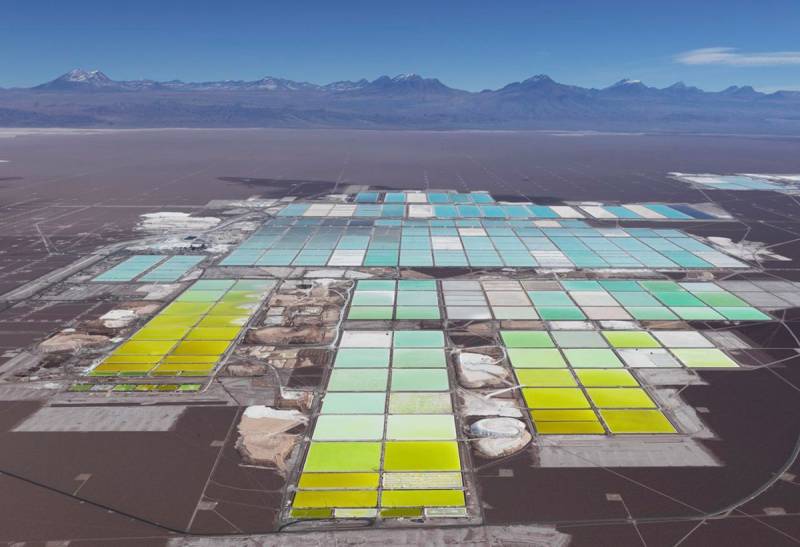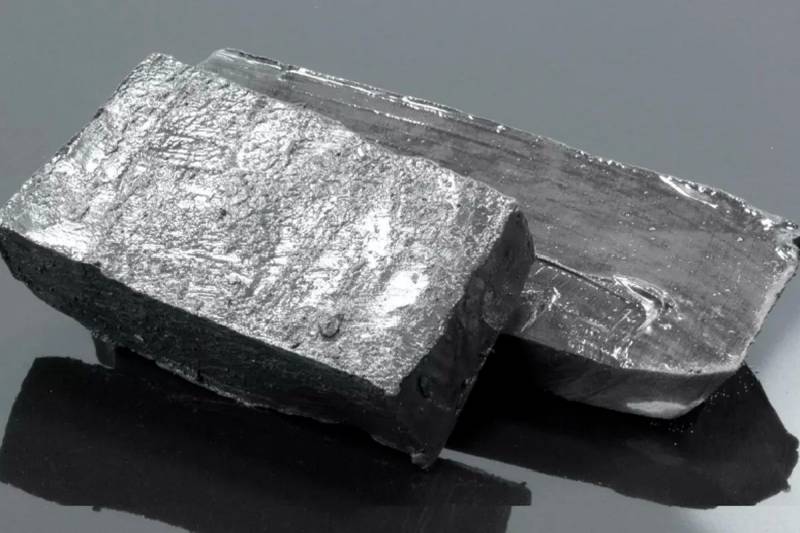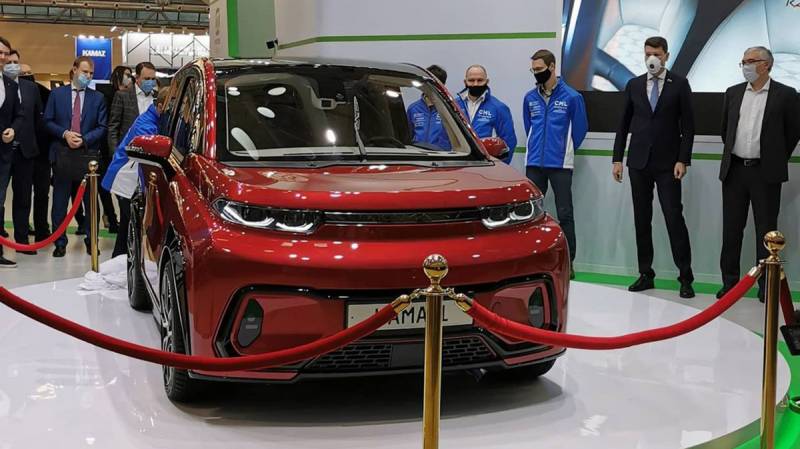"Lithium hunger" destroys the ambitions of Russia

Typical mining of lithium salts in South America. Source: battery-industry.ru
The Reality of Sanctions
Russia has always purchased alkali metal lithium from abroad, mainly from Chile, Argentina and Bolivia. There were times when the Soviet Union ranked second in the world in terms of production of this metal, second only to the United States. But the 90s came and lithium mining in Russia turned out to be unprofitable. Meanwhile, the first lithium mine appeared back in 1941 in Eastern Transbaikalia at the Zavitinsky deposit. In 1997 it was closed.
February 2022 came and sanctions fell on Russia. And not only from countries that we are accustomed to associate with the collective West, but from those who were quite loyal before. Argentina and Chile stopped supplying lithium to our country. This is understandable - local industrialists are closely connected with Elon Musk and his Tesla. So far, Bolivia has remained the exclusive supplier, but so far it has not reached the hands of Washington. Optimists believe that now it is not worth worrying about the supply of lithium raw materials from Bolivia - the government in the country is now completely loyal to the Kremlin. Pessimists point to the volume of production and consumption. Every year Russia buys about 7-8 thousand tons of lithium carbonate, while Bolivia is able to produce only about 2 thousand tons annually. This imbalance threatens to leave our country without lithium raw materials.

Lithium. Source: atomic-energy.ru
Meanwhile, lithium is of strategic importance for Russia. And the point is not even in lithium-ion batteries, which are talked about on every corner, but in a wide range of civilian and defense products. Alkali metal is used in the manufacture of special alloys, for example, paired with aluminum for aviation industry. The nuclear industry vitally needs lithium as a coolant in reactors to produce the radioactive hydrogen isotope tritium, which, in turn, is used as a shielding agent to search for thermal neutrons. Pharmacists use lithium salts as the basis for a wide range of drugs. Not surprisingly, Vladislav Demidov, deputy director of the department of metallurgy and materials of the Russian Ministry of Industry and Trade, almost panicked when Russia blocked part of the supply of lithium. According to him, the country is facing "giant" problems.
The emerging “lithium hunger” becomes especially relevant after reading the “Concept for the development of production and use of electric road transport in the Russian Federation for the period up to 2030”. If you believe this document, which so far has not been canceled or corrected by anyone, then next year at least 25 thousand electric vehicles should be produced in Russia. And by 2030, every tenth vehicle produced in the country will not have an internal combustion engine - its place will be taken by an electric motor and a lithium-ion traction battery. Without exaggeration, this is a real technological revolution in a single country. To understand the situation, let's give an example - at the moment in Russia there is no mass production of the simplest by world standards ABS modules and airbag control units. And here is the mass production of the most complex electric vehicles. However, this program has an obvious solution - to give everything at the mercy of the Chinese. In China, ten percent of new cars are already battery-powered. They know how to make batteries (there are a lot of their own reserves of lithium for this), and electric cars. Approximately as now in Moscow they have mastered the production of the “originally Russian Moskvich”, but in fact, the screwdriver assembly of the Chinese JAC.
Hope that the electric future will not be quite the same as with the "Moskvich", give plans to build a Russian gigafactory in the Kaliningrad region. We are talking about the Rosatom project aimed at creating a plant for the production of batteries for electric vehicles. In 2026, the production of lithium-ion batteries for 45 electric cars, most of which will be passenger cars, will be launched near the Baltic NPP. By the way, the production of strategically important products was located just ten kilometers from the NATO country - Lithuania. Managers explain that the Russian enclave in the very heart of Europe was not chosen by chance - supposedly, transport accessibility is at the level here, and the climate allows for year-round construction, and the technological readiness of the site. Particularly touching is the "transport accessibility" in the light of the not so long-standing blockade by Lithuania. But let's leave it on the conscience of the designers. According to the plan, the total capacity of the produced batteries should be at least 3 GWh per year, and in the future, a fourfold increase in capacity is possible. Among the consumers of products are KamAZ, GAZ, the local Kaliningrad Avtotor, Volgabas and, possibly, AvtoVAZ. Rosatom will develop battery production technology in cooperation with South Korean Enertech International - and this is another bottleneck of the project, if you remember how dependent Seoul is on Washington's opinion.
It's all about this stories the only thing left is to find the necessary volumes of lithium, taking into account the constantly growing needs of Russia.
Lithium made in Russia
For the time being, there is no need to worry about the needs of Rosatom - according to media reports, the industry has accumulated the volume of raw materials necessary for the first time. Atomists are hinting that they are ready to invest in the expansion of mining and production of lithium carbonate in Bolivia. Some experts call this country "lithium Saudi Arabia”, and whoever manages to develop considerable reserves first will take a good jackpot. Bolivia has already announced a competition for development - at the moment six companies are participating. Of these, one American office, four Chinese and Russian Uranium One from the Rosatom structure. The plans include a multiple increase in lithium production in Bolivia and, of course, priority supplies to Russia. There are at least two dangers here. First, given the level of anti-Russian pressure, no one can guarantee the stability of the Russian project in Bolivia in two or three years. The second is that a massive switch to Bolivian raw materials will again make domestic production unprofitable. Why the mentioned Uranium One cannot launch lithium mining in Russia is a question that is still unanswered.
There are developments in Russia's own production of alkali metal, it remains only to wait for the transition from words to deeds.
It’s worth starting with the fact that the country ranks third in the world in terms of reserves of this valuable metal. Of course, lithium salts do not lie underfoot, as in South America, but they are also quite mined. Although it is more difficult and more expensive. But then he has technological sovereignty in order to sacrifice something for the sake of a brighter future. Natural piggy bank of lithium salts are Eastern Siberia, the Murmansk region and the Far East. Norilsk Nickel is already eyeing one of them and has entered into an agreement with Rosatom to develop the Kolmozerskoye mine in the country's northwest. Up to twenty percent of the explored reserves of lithium are concentrated here, and mining has to be carried out by mine or quarrying. This is one of the most expensive ways to mine lithium, although high metal prices offset the costs. Over the past couple of years, the cost of lithium carbonate has risen from $13 to $75. According to pessimists, it will be possible to organize work at the field practically from scratch no earlier than in five to seven years. There is also the option of reusing dumps, for example, at the Zavitinskoye field mentioned above. Technology has stepped forward noticeably, and now a lot of valuable raw materials can be obtained from “mining”. According to A. Nesterenko, director of the KPMG strategic and operational consulting practice, this will take one or two years. True, this will not allow to completely cover Russia's needs for lithium.

The government has very ambitious plans for electric transport in Russia. In the photo, the Kama-1 electric car. Source: kamaz45.ru
Fast forward to the Irkutsk region, to the Kovykinskoye gas condensate field of Gazprom, where they plan to organize the extraction of lithium salts from local groundwater. This is cheaper than extracting from the solid minerals of the Murmansk region, but also very costly. The necessary documents for launching the project were signed even before the start of the special military operation in Ukraine. As usual in such cases, a road map has been prepared.
At least a billion rubles will be needed to develop the large Yuzhno-Sukhokumskoye lithium deposit in Dagestan. Here it is possible to "evaporate" up to 6 thousand tons of raw materials, which almost covers Russia's annual demand at the present time. And there are a lot of such underground lithium-bearing brines in Dagestan. According to scientists of the Russian Academy of Sciences, it is the North Caucasus that should become the locomotive of the alkali metal mining industry.
At the moment, one thing is clear - a shortage of lithium in Russia is just around the corner. On paper, at least three mining sites are being organized, and it remains only to wait for real steps. And if both businessmen and the government take everything that is planned really seriously, then Russia may have “new gold”. Let not liquid, but no less valuable.
Information